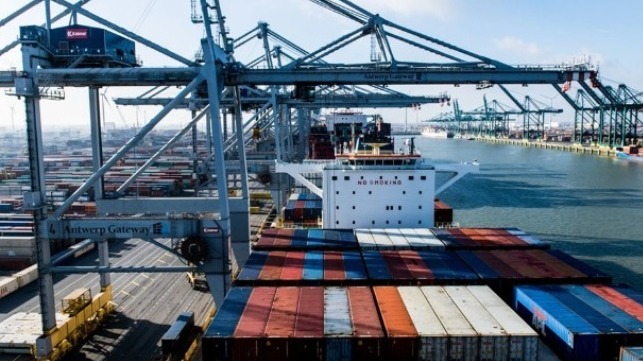Northern European Ports Target Shore Power for Large Containerships

Faced with growing calls to improve the environment around major ports and with pending EU regulatory actions requiring ships to reduce emissions while in port, five of Northern Europe’s largest port authorities announced a joint effort focusing on increasing the use of onshore power supply for ships at berth. While the use of cold ironing has been increasing for some segments, such as passenger ships, harbor crafts, and inland vessels, the new memorandum of understanding among the ports focuses on expanding the use of shore power for large container ships. The ports are agreeing to equip all their container terminals for shore power by 2028.
The ports of Antwerp, Bremerhaven, Hamburg, Haropa Port, and Rotterdam decided to examine what they can undertake to create further progress and increase the efforts already underway at a regional, national, and international level. The five port authorities are calling for a coordinated approach to reduce capex costs through innovation and to provide clarity that will stimulate the shipping sector to equip vessels and make it possible for vessels to use shore power in multiple ports. Working together they plan to create a level playing field for the use of shore power in their respective ports.
“With the joint declaration of the major European container ports on the North Range, we are getting a little closer to zero-emission shipping in line with our greenports strategy,” said Robert Howe, CEO Bremerhaven. “To invest in emission-free drives that have an impact both at sea and in ports is the best solution to address the emissions contributing to climate change. Together with Haropa Port, Antwerp, Rotterdam, and Hamburg, we are sending, therefore, an important signal for fair competition, for clean shipping and clean supply chains, for maritime climate protection.”
The ports acknowledged that onshore power cannot be the solution for all berths, vessel types, and sizes of vessel, but they believe that significant steps forward can be taken in the ultra-large containership segment. They highlighted a strong business case for retrofitting or equipping large container ships for shore power and point to the level of readiness among these vessels to use cold ironing. They also said the call frequency of containerships at the terminals, the average berth duration, and the high-power demand of these ships create the case to focus on this segment.
Considering the size and energy demand of ships, the deployment of onshore power however will require large investments with technological challenges to be overcome the ports noted. These mainly relate to frequency conversion, grid connections, and flexibility needs, which, together with a lack of public funding, the uncertainty regarding the use of the installation, and the price difference between bunker fuels and electricity, constitute just a few of the many hurdles that are currently delaying the uptake of this technology.
“We call upon policymakers, private and public stakeholders to join our initiative and put in place the right framework to enable a step forward in the deployment of OPS to the benefit of emission reductions in our ports and the further greening of the shipping sector,” said Jacques Vandermeiren, CEO Port of Antwerp.
Several of the ports noted that they already have multiple efforts underway for shore power. Rotterdam, for example, has already realized several shore power projects and is planning to execute ten more, bigger scale projects in the next few years and then to scale up based on the experience gained. Haropa Port also has ongoing projects for the maritime cruise terminal in Le Havre and along the Seine from Paris to Le Havre for inland cruise and inland freight vessels sailing through Rouen.
